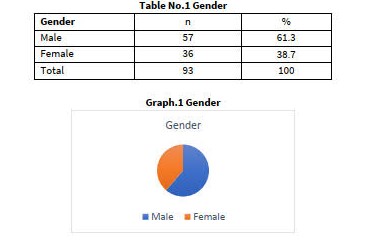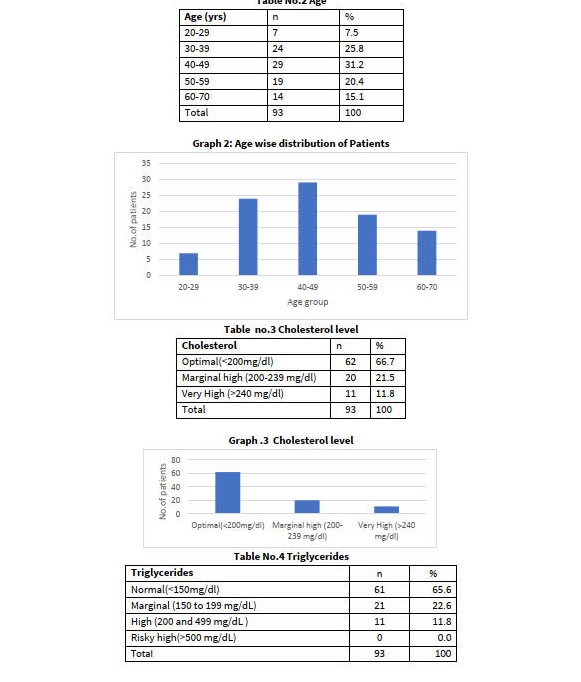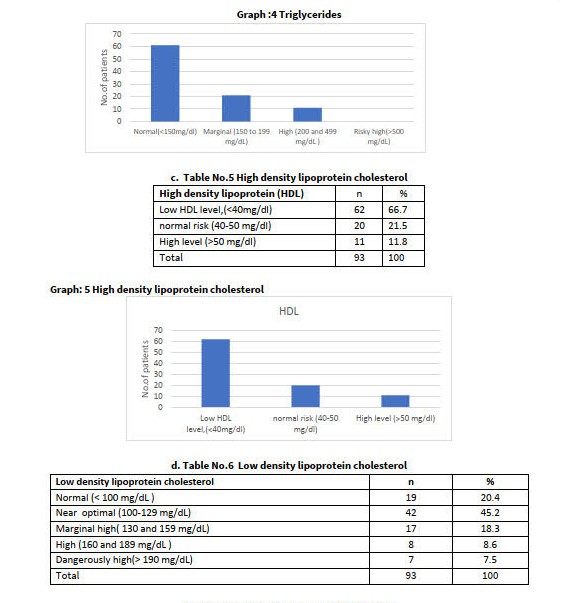Original Article
Year: 2021 |Volume: 2 | Issue: 02 |Pages: 41-47
A cross sectional study on lipid profile among patient attending Govt Ayurveda Hospital.
About Author
Correspondence Address:
Dr. Dhananjay Hange Assistant Professor, Department of Rog nidan, Government Ayurvedic college, Nagpur. drdvhange@gmail.com Mobile no.9822246598
Date of Acceptance: 2021-02-25
Date of Publication:2021-03-01
Article-ID:IJIM_60_03_21 http://ijim.co.in
Source of Support: NIL
Conflict of Interest: NIL
How To Cite This Article: Hange D, Bawankar R, Sahu Preeti, Umale A S, Meshram R M. “A cross sectional study on lipid profile among patient attending Govt Ayurveda Hospital.Int. J Ind. Med. 2021;2(2):41-50
Abstract
Background: Atisthaulya (obesity) is considered as one of the ‘Astonidya Purush’ as described by Acharya Charaka. A person having excessive accumulation of Meda (fat/adipose tissue) and Mamsa (muscle tissue) leading to flabbiness of hips, abdomen, and breast has been categorized as Atisthula according to Ayurveda. Objectives: To study lipid profile among the patient attending OPD of the Govt Ayurveda Hospital. Methodology: It was a cross sectional study and total 93 patients were recruited for lipid profile. Sampling technique implemented was Non probability convenience sampling. Results: It was observed that , among 93 patients, 62[66.7%] patients were having Cholesterol level below 200mg/dl, while among 11 [11.8%] patients Cholesterol level was very high i.e.,>240 mg /dl. Total 21[22.6%] patients were having Marginal level of Triglycerides (150 to 199 mg/dL) while among 11 [11.8%] patients’ high level of Triglycerides. Total 62[66.7%] patients were High density, 11 [11.8%] patients’ High level (>50 mg/dl) of High-density lipoprotein cholesterol. Conclusion: Community awareness of regular exercise and healthy diet is needed to maintain the normal level of lipids.
Keywords: Atisthaulya, Hyperlipidemia, Fat, Meda, Medoroga etc
Introduction
A person having excessive accumulation of Meda (fat/adipose tissue) and Mamsa (muscle tissue) leading to flabbiness of hips, abdomen, and breast has been categorized as Atisthula according to Ayurveda. Atisthaulya (obesity) is considered as one of the eight despicable conditions as described by Acharya Charaka.1 Due to life style changes and diet pattern Santarpanottha Vikaras (diseases due to faulty and excessive nutrition) are increasing globally. The prevalence of obesity, Diabetes, Coronary and Cerebrovascular disease worldwide is an increasing and the concern surrounding the rising rates with the consequent health and financial implications for the population.2 Obesity, Hyperlipidemia is considered as one of the greatest risk factors for coronary artery diseases as well as ischemic heart diseases. Obesity is most commonly caused by a combination of excessive food intake, lack of physical activity, and genetic susceptibility.3
Concept of meda:
Medas is body tissue predominant in Prithvi and Ap Mahabhutas similar to Kapha Dosha.4 Sneha (oleation), Sweda (production of sweat), Drudhatva (compactness), and Asthipushti (nourishment of bones) are the main function of Medodhatu.5 Lack of physical exercise, sleep during day time and intake of excess sweet and oily food increasing Shleshma, sweat and unctuousness (Snigdha), which resulting cause and produce fat in excess.6 In Ayurveda, Abnormal composition of is Medodhatu considered as Medodosha & subsequently as Medoroga. Accumulated Medo cause disturbance to the action of Vata, which cause increased appetite , due to Chala Guna of Vata. Patients therefore eat more and the entire food is abnormally converted into Medodhatu.7 Meda further continues to develop constantly resulting in growth of meda in excessive amount, extra ordinarily. As the result (excessive growth, production and higher amount of Meda (fat-excessiveness), due to these patients of Sthaulya is unable for the physical activities and body movements, thus, unable in any action on account of extra deposit of fat in the body. Agni (digestive fire) contributes its moieties to the Dhatu or Dhatwagni dealing with tissue metabolism. Ama (undigested toxic substance) which results from hypo functioning of Jatharagni (digestive fire) may clog to the Srotas (channels) leading to Srotorodha (obstruction of channels) which in turn increases Medodushti and decreases the nutrient supply to subsequent Dhatus namely Asthi (bone tissue), Majja (bone marrow), and Shukra (fertility promoting substance).8
Lipids profile tests:9
The lipid profile test is a combination of tests performed together to check for any risks of coronary heart disease , hyperlipidemia, or as a preventive measure to check any risks depending on factors like eating habits, diet, stress, exercise and life-style related. A typical lipid profile includes the following tests:
- High density lipoprotein cholesterol (HDL-C) - “ good cholesterol”
- Low density lipoprotein cholesterol (LDL-C) -“ bad cholesterol”
- LDL/HDL Ratio (calculated values)
- Triglycerides
- Very low-density lipoprotein cholesterol (VLDL-C)
Normal range of lipids in the body:10
Total Cholesterol
Optimal : below 200 mg/dL
Marginal high : 200-239 mg/dL
Very High : 240 mg/dL
LDL Cholesterol
Normal : Below or equal to 100 mg/dL
Near/above optimal : 100-129 mg/dL
Marginal high : Between 130 and 159 mg/dL
High : Between 160 and 189 mg/dL
Dangerously high : More than 190 mg/dL
HDL Cholesterol
Low HDL level, high risk: below 40 mg/dL in female
Normal risk: between 40 to 50 mg/dL in male and from 50 to 59 mg/dl in female
High level, below average risk : 60 mg/dL or more in both male and female
Fasting Triglycerides
Normal : below 150 mg/dL
Marginal : Between150 to 199 mg/dL
High : Between 200 and 499 mg/dL
Risky high : above 500 mg/dL
Objectives:
To study lipid profile variations among patients attending OPD of the Hospital.
Methodology:
Source of Data:
Types of study design: A cross sectional study
Setting (location of study design): Out Patient Department of Rognidan Ayurveda College & Hospital, Nagpur.
Duration of study : Six months
Sample size: Total 93 patients were recruited for lipid profile test attending OPD of Rognidan, Govt Ayurveda Hospital, Nagpur.
Sampling technique: Non probability convenience sampling
Method of selection :
Inclusion Criteria:
Age between 20 to 70 years and patients who are willing to participate and give informed consent for this study.
Exclusion criteria:
Known case of as diabetes, cardiovascular diseases, having blood pressure >160/100 mmHg.
Test procedure:
All patients were advised to come hospital on fasting to give blood samples as it needs to be collected after a minimum 12-14 hour overnight fasting status.
Results: In this study, 93 patients attending OPD of Rognidan, Govt Ayurveda Hospital, Nagpur were taken. All these patients were screened and advised to lipid profile test empty stomach. Specially designed Case Report Form (CRF) was used to record all information and medical history of Patients.

img 1

img 2

img 3
Discussion
A person whose fat and muscular tissues are excessively increased, that appearance of Sphika (Hip), Udara (Abdomen) Stana (Chest) due to excess deposition of Meda along with Mamsa Dhatu, breasts are movable and also having unequal or abnormal distribution of Meda with reduced zeal towards life &whose metabolism is impaired is called as “Atisthula”(Obese) or Medoroga.11 Lipids are the simple substances containing hydrocarbons. They, along with carbohydrates, protein, and nucleic acid, make for the four most biologically essential components required by the body for carrying out its day-to-day functions. Cholesterol is a type of fat required for body, as its function is to maintain the outer membranes of our bodies' cells stable. Before a decade, most of physicians in the opine that people with high total cholesterol levels are more likely to get heart diseases. However recently, it was observed that the different forms of cholesterol HDL or LDL (‘good’ and ‘bad’) also play a significant role.
A Lipid Profile test measures the quantities of the following components:-
- Total cholesterol/HDL cholesterol ratio
- Serum Phospholipids
- Serum HDL Cholesterol
- Serum Total Cholesterol
- Serum Triglycerides
- Total lipids
- Electrophoretic fractionation determines the percentage of
- Low-Density Lipoprotein – LDL
- Chylomicrons
- Very Low-Density Lipoprotein – VLDL
- High-Density Lipoprotein – HDL
In this study , it was observed that, totally 36[38.7%] were female and 57 [61.3%] were male while more male was recruited in study it may be due random selection of patients. As per inclusion criteria of patients were selected having age between 20 years to 70 yrs. and distributed it in five-sub age groups. Out of 93 patients’ number of patients found in age group 20-29 were 7 [7.5%], patient from age group 30 to 39 yrs. were 24[25.8%], in 40 to 49 yrs. age group were 29[31.2%], in 50 to 59 yrs. age group were 19[20.4%], while 14[15.1%] patients from age group 60-70 years.
Lipid profile:
Cholesterol level
It was observed that , among 93 patients, 62[66.7%] patients were having Cholesterol level below 200mg/dl, 20[21.5%] patients were having Cholesterol level Marginal high (200-239 mg/dl) while among 11 [11.8%] patients Cholesterol level was very high i.e.,>240 mg /dl.
Triglycerides level:
Among 93 patients, 61[65.6%] patients were having normal Triglycerides level below 150mg/dl, 21[22.6%] patients were having Marginal level of Triglycerides (150 to 199 mg/dL) while among 11 [11.8%] patients’ high level of Triglycerides.
High density lipoprotein cholesterol.
It was observed that , among 93 patients, 62[66.7%] patients were High density lipoprotein cholesterol Low HDL level(<40mg/dl), 20[21.5%] patients were having normal risk (40-50 mg/dl) while among 11 [11.8%] patients’ High level (>50 mg/dl) of High-density lipoprotein cholesterol.
Low density lipoprotein cholesterol :
It was observed that , among 93 patients, 19[20.4%] patients were having Normal (<100 mg/dL) level of low-density lipoprotein cholesterol, 42[45.2%] patients were having Near optimal (100-129 mg/dL), 17[18.33%] were having Marginal high( 130 and 159 mg/dL) level of LDL, while among 8 [8.6%] patients having High level (160 and 189 mg/dL) of LDL and 7[7.5%] patients were having Dangerously high(> 190 mg/dL) level of LDL.
Conclusion
In this cross-sectional study, it was observed that majority of participants were having within normal range of profile High density lipoprotein cholesterol, Low density lipoprotein cholesterol, total cholesterol and Triglycerides level. However, a significant participant were above the normal limit of lipid profile. Community awareness of regular exercise and healthy diet is needed to maintain the normal level of lipids to prevent communicable diseases like hyperlipidaemia, obesity and cardiac disorders.
References
- Agnivesha, Charaka, Dridhabala . In: Charaka Samhita, Sutra Sthana, Ashtauninditeeya Adhyaya, 21/3. 5th ed. Vaidya Jadavaji Trikamji Aacharya., editor. Varanasi: Chaukhamba Sanskrit Sansthan; 2009. p. 116
- Gallagher EJ, Leroith D, Karnieli E Med Clin North Am. 2011 Sep; 95(5):855-73.
- Yazdi, FT; Clee, SM; Meyre, D (2015). "Obesity genetics in mouse and human: back and forth, and back again". PeerJ. 3: e856. doi:10.7717/peerj.856.
- Chakrapanidutta. In: Commentator, Sushruta Samhita, Sutra Sthana, Doshadhatumalakshaya vruddhi Vijnaniya Adhyaya, 15/4. 8th ed. Vaidya Jadavji Trikamji Acharya., editor. Varanasi: Choukhambha Orientalia; 2005. p. 68.
- Sushruta . In: Sushruta Samhita, Sutra Sthana, Doshadhatumalakshayavruddhi Vijnaniya Adhyaya, 15/4. 8th ed. Vaidya Jadavji Trikamji Acharya., editor. Varanasi: Choukhambha Orientalia; 2005. p. 67
- Shastri Kashinath & GorakhnathChaturvedi, Charaka Samhita of Agnive-sha elaborated Vidyotini Hindi commen-tary, Sutra sthana 21stchapter Ashtanindi-tiya, Chaukhambha Bharati Sansthan, Va-ranasi, reprint edition; 2005. p. 411
- Kaviraj Atridevagupta Vagbhata ‘Astangasamgraha with Hindi Commentary Vol -1, Published By Chaukhambha Krishnadas Academy ,Varanasi 2005 ,Page -183.
- Agnivesha, Charaka, Dridhabala . In: Charaka Samhita, Sutra Sthana, Ashtauninditeeya Adhyaya, 21/4. 5th ed. Vaidya Jadavaji Trikamji Aacharya., editor. Varanasi: Chaukhamba Sanskrit Sansthan; 2009. p. 116.
- https://www.portea.com/labs/diagnostic-tests/lipid-profile-69/#section_0 [cited on 24.2.2021]
- https://www.lalpathlabs.com/blog/what-is-lipid-profile/ cited on 23.02.2021
- Shukla V, editor, (2nd ed.). Charaka Samhita of Charak, Sutrastana: Chapter 21, Verse 8-9. Varanasi: Chowkhambha Sanskrit Series, 2002; 372

